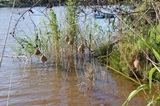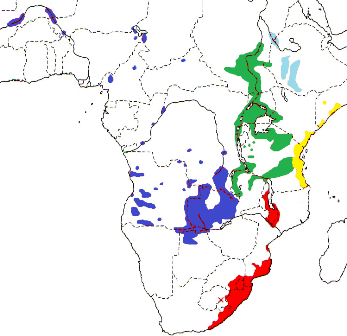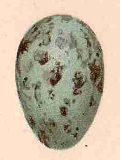Weaver species
Choose different species from drop-down list and press 'Go' button. See Full species list.Fan-tailed Widowbird Euplectes axillaris
IUCN: Least concern Discovery: 040Categories: wetland, pest, blue-billed widows,
News items about species
Discovery
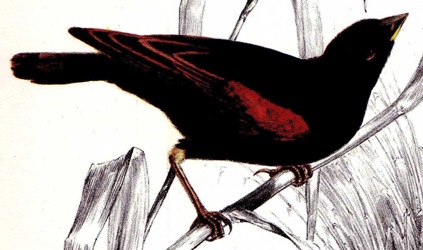
figure from Smith 1838 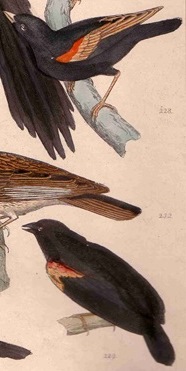
figures from Reichenbach 1863 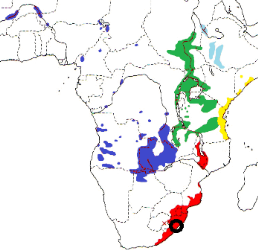
distribution, type locality circled IntroductionThe Fan-tailed Widowbird was collected and formally described by Andrew Smith, a Scottish surgeon, explorer, ethnologist and zoologist. Smith organised an expedition to the interior and he travelled to near the Botswana border in 1834-35, collecting many new birds, reptiles, mammals and other taxa along the way.Smith described this species from a specimen 'obtained upon the south-east coast . . . in Caffreland' (Smith 1838). Smith actually described this species earlier, but did not provide a specific name (Vidua sp., Smith 1831), but he did give the locality as near the Kei River (Smith 1831), Eastern Cape, South Africa. The specimen could have been collected anytime between 1820 to 1831. Smith crossed the Great Kei River on his trip to KwaZulu-Natal in 1832, but clearly he must have collected Fan-tailed Widowbird on an earlier excursion to the Kei. The first illustration of a Fan-tailed Widowbird was published by Andrew Smith in 1838 in Illustrations of the Zoology of South Africa, being painted by George Henry Ford. The next illustration was published in Reichenbach (1863), who painted 2 males in different poses. Scientific citationVidua axillaris Smith 1838; Illustr. Zool. South Africa, Aves, pl. 17 (and text); 'between seven and eight hundred miles to the eastward of Cape Town ... in Caffreland' = eastern Cape.Meaning of namesaxillaris - Latin: axillaris, of the armpit, shoulders or wing (axilla, the armpit, shoulder or wing; ala, the wing).First English nameEpauletted Widow-bird (Gurney 1860).Alternate namesAbyssinian Fan-tailed Widow-Bird, Benguella Fan-tailed Widow-Bird, Bocage's (Fan-tailed) Whydah, Bocage's Widow Bird, Epauletted Widow-bird, Fan tailed Widow Bird, Fan-tailed Whydah, Malandje Fan-tailed Widow-Bird, Natal Fan-tailed Weaver, Niger Fan-tailed Whydah, Nile Fan-tailed Widow-Bird, Red-shouldered Whydah, Red-shouldered Widow Bird, The short-tailed red-shouldered Widow, Zanzibar Fan-tailed Widow-Bird.CollectorAndrew Smith.Date collectedBetween 1820-31.Locality collectedGreat Kei River, Eastern Cape, South Africa.Type specimensNot traced. |
The above is based on Weaver Wednesday 2, a weekly series about the discovery of each weaver species.
This species text first appeared as
Weaver Wednesday [157] - Discovery [40]: Fan-tailed Widowbird on 2015-06-17
1. Basic biology
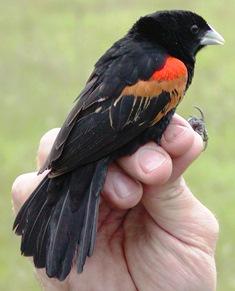
male, nominate race 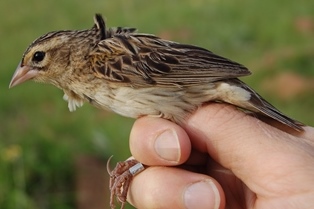
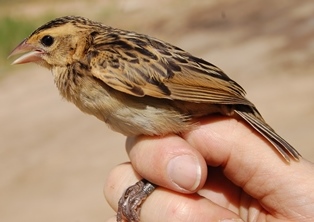
Identification. The Fan-tailed Widowbird Euplectes axillaris breeding male is black with a pale blue-grey bill, orange-red and cinnamon shoulder patch. The broad fan-shaped tail is much shorter than that of the Hartlaub's Widowbird F. hartlaubi. The non-breeding male is dull with heavy streaking above, a dark crown, conspicuous pale supercilium, red shoulder patches, and black primaries. The female is similar but has brown primaries, and duller shoulder. All ages and sexes have a distinguishing cinnamon underwing. Distribution.
Five subspecies of the Fan-tailed Widowbird are recognised (see map below, based on Handbook of the Birds of the World, Vol. 15:
Habitat. The Fan-tailed Widowbird inhabits tall moist grassland and swamp edges, but at the coast also occurs in dry savanna and cultivation including sugarcane fields. It is gregarious, forming large post-breeding flocks. It roosts and feeds with other weavers. Ringed adults in South Africa have survived for longer than 9 years (see weaver longevities). Food. The Fan-tailed Widowbird feeds on seeds of grasses, herbs and rice; and also eats insects, including termites and caterpillars. Breeding.
The Fan-tailed Widowbird is polygynous and territorial. A male owns up to 8 nests in his territory. The male flies over his territory in a slow, undulating flight, just above the vegetation, then suddenly alights on a tall grass stem. The male sings from a prominent perch, with epaulets conspicuous, and tail spread. If a female lands in his territory, the male displays with wings arched and spread, bouncing up and down in front of the female, and singing loudly. The male also sings at his nest frame, swaying from side to side. The epaulet colour is important in male-male interactions, while tail length is important in attracting females.
The nest is an oval ball of thin woven grass strips, with a dense lining of seed-heads projecting from the entrance. The nest is attached to 2 or more stems of grass or other plants. The male builds the frame, weaving long grass strands into the bower of living grass. The female packs lining of up to 540 grass seedheads in the nest. The clutch is 2-3 eggs which are pale blue-green, irregularly marked with large olive or brown markings. Incubation is by the female only, as is feeding of the chicks. |
The above is based on Weaver Wednesday, a weekly series about weaver species.
This species text first appeared as
Weaver Wednesday [85]: Fan-tailed Widowbird on 2014-01-29
2. Breeding facts
| Pair bond Polygynous Breeding season Sept-Oct in W Africa, Aug in Sudan, Sept-Oct in Ethiopia and Aug-Oct in Somalia; in all months except Jan, primarily Mar-Jul, in Uganda; in DRCongo, Aug-Oct in N and Jan-Mar in S; Nov-Dec and Feb-Jun in Rwanda, Apr-Jul in Kenya, Mar in Tanzania, Jan-Apr in Angola, Jan-Mar in Zambia and Dec-Mar in Malawi; one Mar record for Zimbabwe; Oct-Mar in South Africa Nest site usually 60-80 cm above ground, sometimes only l0 cm from ground in shorter grass tufts Nest building male weaves frame, female then adds dense lining Colony size up to eight nests in a teritory of 0.6 ha Clutch size 2-3 eggs (mean 2.8 in South Africa) Egg colour pale blue-green, irregularly marked with large olive-brown spots, or grey-green with interlaced brown flecks, or olive-green with sparse brown markings, or grey-white with overlying brown streaks and blotches Egg size average size of 69 eggs 19.7 x 14.1 mm (South Africa) Incubation incubation by female only, period 12-14 days Chicks and nestling period chicks fed by female only, faecal sacs dropped 100 m from nest, nestling period 15-16 days; in captivity, young fed by female for 14 days after leaving nest |
Breeding information based on Handbook of the Birds of the World, Vol. 15.
3. Photos of Weaver Nests
 Vm 28563 |  Vm 15814 |  Vm 15811 |  Vm 15810 |  Vm 15809 |  Vm 14708 |
Thumb-nails of most recent PHOWN records - click on one to see its full record
See all PHOWN records for this species here.
PHOWN (Photos of Weaver Nests) provides valuable info on breeding distribution and colony sizes of weavers.
You can contribute by registering and submitting photos at Virtual Museum webpage.
4. Breeding distribution
Google map showing distribution (For species with small ranges you need to zoom in at the correct area to see the range):
yellow blob - range of weaver species; read more about this here.
![]() - PHOWN records with photos
- PHOWN records with photos
![]() - PHOWN records with no photos (Nest Record Cards, other records)
- PHOWN records with no photos (Nest Record Cards, other records)
![]() - Birdpix records
- Birdpix records
![]() - comments on out of range records, or interesting records
- comments on out of range records, or interesting records
![]() - type locality
- type locality
CLICK on the marker on the map to see individual record details.
5. Range changes
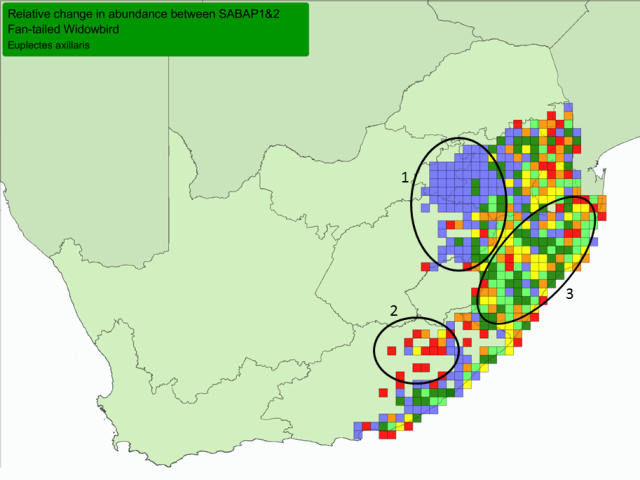
Red, orange and yellow = cells with very large, large, and small relative decreases Blue, dark green and light green = cells with very large, large and small relative increases. Cells = quarter-degree grid cells; Only cells with at least 4 checklists in both SABAP1&2 shown. All cells had this species recorded in SABAP1 or in SABAP2 or in both (more about interpretation at Biodiversity Observations 7.62: 1-13).
Range changes in SA
The points below match the points on the map above. Areas with very large increases include:
Areas with very large decreases include:
Areas with small changes include:
Range changes elsewhereMozambique: increasing on Inhaca Island (de Boer 1999a). | |||||||||||||||||||||||||||||||||||
The above is based on Weaver Wednesday 3, a weekly series about range changes in South African weaver species.
This species text first appeared as
Weaver Wednesday 3 [260] - Range changes [23]: Fan-tailed Widowbird on 2017-06-07








